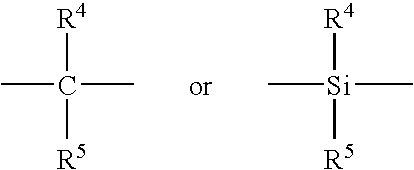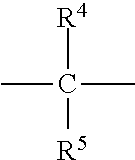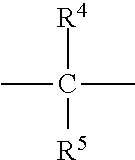Controlling branch level and viscosity of polyalphaolefins with propene addition
a polyalphaolefin and propene technology, applied in the field of polyalphaolefins, to achieve the effects of high viscosity, enhanced thickening efficiency, and good low temperature properties
- Summary
- Abstract
- Description
- Claims
- Application Information
AI Technical Summary
Benefits of technology
Problems solved by technology
Method used
Image
Examples
example 1
[0050]In a glove box, 0.02 grams of Ph2C(Cp-9-Flu)ZrCl2 was weighed into a 25 ml vial. 12 ml of 1.5M MAO was added to the vial and the resulting mixture was dissolved in a shaker for 10 minutes at room temperature.
[0051]A moisture and air free 3 liter Buchi reactor was charged with 670 grams of dry 1-decene monomer. The reactor was then purged with nitrogen. The reactor was brought to a temperature of 90° C. 33 grams of propene was then added to the reactor, which resulted in raising the reactor pressure to 38 psig. Hydrogen was added to the reactor to bring the reactor pressure to 50 psig. Using a dry 5 ml syringe and needle, 5 ml of catalyst solution was added to the reactor. With 550 rpm of agitation, the reaction was allowed to proceed for 30 minutes. The reactor was then vented and purged with nitrogen and the product was allowed to cool to a safe temperature for removal.
[0052]A portion of the reactor contents, 100 grams, was transferred to a vessel equipped with an agitator, a...
example 2
[0054]Example 2 was prepared in the same manner as Example 1, but nitrogen was used in place of the propene being add to the same pressure level increase as found in Example 1. The polymer was determined to have a kinematic viscosity of 760 cSt at 100° C. and a branching level of 19%.
example 3
[0055]A lower level of CoCatalyst:Catalyst and the addition of activator was used. In a glove box, 0.02 grams of Ph2C(Cp-9-Flu)ZrCl2 and 0.0288 grams of dimethylaniliniumtetrakis(pentafluorophenyl)borate were weighed out into a 25 ml vial. 2.4 ml of 1.5M MAO solution and 9.6 grams of toluene were added to the vial and the mixture was allowed to dissolve using a shaker for 10 minutes at room temperature. The remainder of the procedure was the same as Example 1. The polymer in this example was found to have a kinematic viscosity of 967 cSt at 100° C. and a branching level of 22%.
PUM
| Property | Measurement | Unit |
|---|---|---|
| pour point | aaaaa | aaaaa |
| pour point | aaaaa | aaaaa |
| kinematic viscosity | aaaaa | aaaaa |
Abstract
Description
Claims
Application Information
 Login to View More
Login to View More - R&D
- Intellectual Property
- Life Sciences
- Materials
- Tech Scout
- Unparalleled Data Quality
- Higher Quality Content
- 60% Fewer Hallucinations
Browse by: Latest US Patents, China's latest patents, Technical Efficacy Thesaurus, Application Domain, Technology Topic, Popular Technical Reports.
© 2025 PatSnap. All rights reserved.Legal|Privacy policy|Modern Slavery Act Transparency Statement|Sitemap|About US| Contact US: help@patsnap.com



